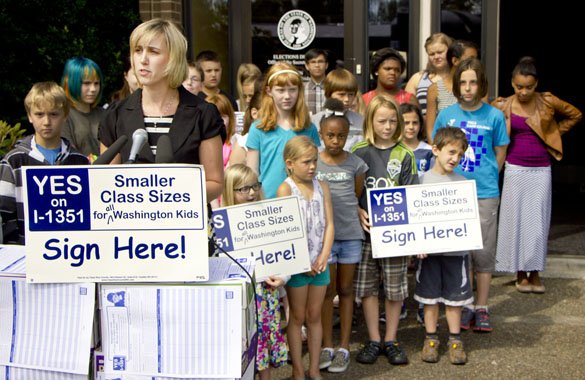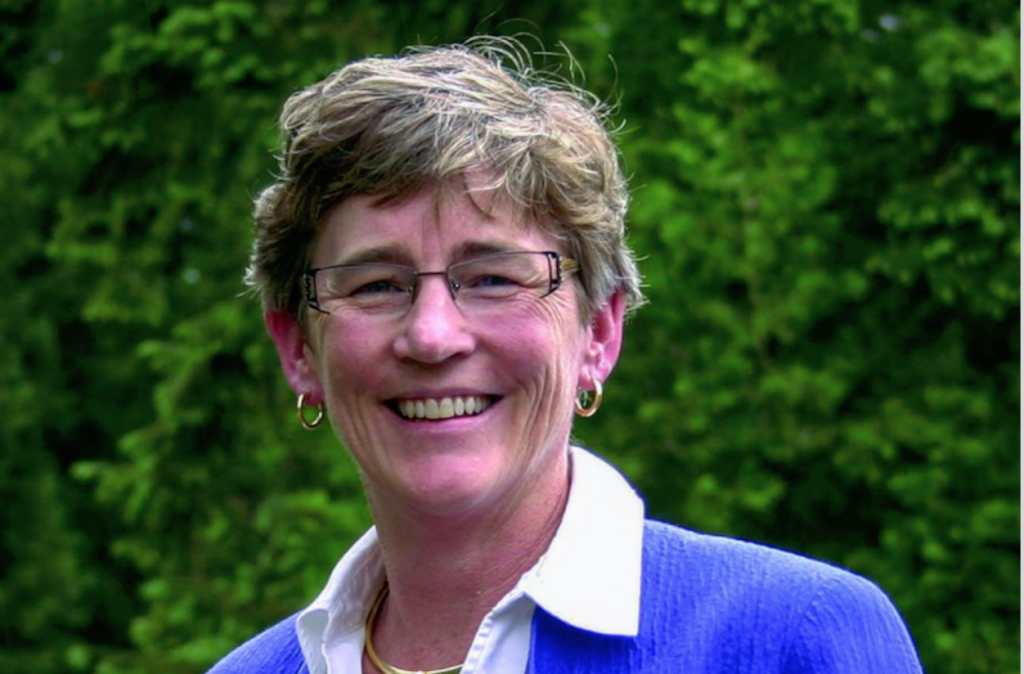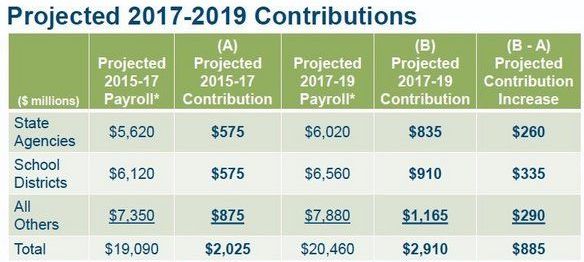When citizens in Washington State headed to the polls in November 2014, one of the decisions facing them was whether to approve Initiative 1351, a proposition aimed at reducing class sizes by requiring the state legislature to pay for an additional 25,000 public school employees by 2019.
For months, an organization called Class Size Counts had been out in force urging voters to approve the measure, claiming that Washington’s public schools were in the grips of an overcrowding crisis. They incessantly cited a report from the National Education Association (NEA) that said the average class size in Evergreen State was one of the highest in the nation. They rallied outside the state capitol in Olympia waving photos of students cleverly photoshopped into sardine cans. Initiative 1351, they insisted, would offer students a brighter future.
Educators and parents at the Capitol today at 13:51 (1:51pm) in support of lower class sizes. Kids aren't sardines! pic.twitter.com/QbhK9f7cH2
— Class Size Counts WA (@ClassSizeWA) June 8, 2015
“I think most voters agree that funding a quality education for our kids is a smart investment,” Class Size Counts campaign manager, Mary Howes, told the Washington State Wire. “Our kids only get one chance at a good education, and 1351 will finally do something to give them the personal attention they need to learn and succeed.”
While supporters of Class Size Counts portrayed it as a “grassroots group of 3,000 parents, teachers, students, and community members,” campaign finance reports show it was actually a ballot committee formed in March 2014. Its web domain was registered by Jeff Lennan, co-founder of Winning Mark, a media firm out of Portland, Oregon, that has worked closely with both NEA and the American Federation of Teachers on several projects. Plus, Mary Howes, the public face of the Class Size Counts campaign, was an official with the Public School Employees of Washington.
NEA gave Class Size Counts $1,550,000 to fund the group’s advocacy efforts. Its state affiliate, the Washington Education Association, sent droves of members out across the state to help the organization gather the 350,000 signatures needed to get the initiative on the ballot.

Meanwhile, opponents of I-1351 balked at its price tag – estimated at upwards of $5 billion – and pointed out that the cash-strapped state government couldn’t bear the added cost. Others questioned how the state’s public schools could be in crisis when Washington consistently outperformed the national average on most educational measures.
A Seattle Times editorial also brought attention to the fact that Class Size Counts was actually bending the truth. The report the group frequently invoked as evidence of overcrowding referred to student-teacher ratio, not average class size, which the paper noted are “very different concepts and cannot be used interchangeably.”
Nevertheless, when the votes were finally tallied after the election, Initiative 1351 passed 51% to 49%. In sum, NEA and its allies manufactured an overcrowding crisis, launched a ballot initiative to address it, and urged the public to vote for it (while conveniently omitting the fact that it would vastly expand their membership base, coffers, and power) and incredibly, it worked.1
The same play, a state away
Now, a coalition of labor interests, led by the teachers unions, is trying to pull off a similar feat – using many of the same tactics and players – in Oregon.
On Thursday, The Oregonian reported that the Oregon Education Association (OEA), an affiliate of the National Education Association, is filing a November 2018 ballot initiative for a new corporate tax that could raise as much as $1.75 billion annually for the state’s public schools.
The move comes less than a year after Oregon voters soundly rejected another ballot initiative, Measure 97, which sought to raise taxes on businesses, although the proceeds were not exclusively earmarked for K-12 education. The “Yes on 97” campaign was led by OEA, who along with NEA and AFT, spent nearly $9 million backing the effort. Interestingly enough, a significant chunk of that money went to Winning Mark, the same Portland-based political media firm that was behind Class Size Counts in Washington State. Campaign finance reports reveal the group received nearly $2.4 million from the “Yes on 97” committee last year.
This time around, OEA and its allies are more narrowly tailoring their message to focus on education, claiming that extra tax revenues are needed to address an overcrowding crisis in the state’s public schools.
“Parents and students are fed up with having the third largest class sizes in the nation,” OEA president Hanna Vaandering said in a press release last week. “Having strong public schools is an Oregon value, but you would never know by looking at the Oregon legislature. These ballot measures seek to put the power back in the hands of the people, not the powerful business lobbyists that control Salem.”
OEA has been throwing around that “third largest class sizes in the nation” statistic (which comes from NEA’s 2015 Annual Rankings & Estimates Report) a lot lately. In fact, it figured prominently in an op-ed co-written by Vaandering that recently appeared in The Oregonian, which also asserted that Oregon ranked 39th in per-pupil funding.
However, OEA is employing the same rhetorical slight-of-hand that their friends in Washington State did during the I-1351 campaign. The NEA report referenced actually said Oregon had the third-highest student-teacher ratio in the country, not class sizes. Moreover, NEA’s 2016 update of the report, which also came out in May, ranked Oregon fifth for student-teacher ratio and 20th in per-pupil funding, not 39th as Vaandering has stated.

A diversionary tactic?
Why is OEA using misleading and inaccurate facts in its latest ballot initiative push? I suspect there’s a method to their madness. By creating the illusion that Oregon’s public schools are in crisis and pinning the blame on state lawmakers for failing to adequately fund them, the union can divert attention from the real threat to public education: skyrocketing health care costs and pension obligations.
Oregon has the highest public employee health care insurance costs on the West Coast, a problem compounded by the fact that state workers contribute a far smaller amount toward their premiums than their counterparts in California and Washington. As a result, public employers, including school districts, have been forced to spend an ever-larger share of their budgets on those benefits.
At the same time, Oregon’s generous Public Employees Retirement System (PERS) is facing a $22 billion unfunded liability. To close that gap, school systems and other state agencies, who already divert about 17.5% of payroll to PERS, will likely see that rate nearly double over the next several years to 32.5%.

It’s been clear for well over a decade that health care and retirement costs would continue to climb unless those systems were restructured. Yet time and again, OEA and their allies have used their considerable political influence to block reform proposals in the legislature.
So it’s curious that just when school district budgets are being squeezed by those health care and pension obligations, OEA is asking voters to raise tax revenues to address a sudden overcrowding crisis in the state’s public schools. Given the fact that we’ve seen the unions employ this class size routine before, Oregonians have reason to be skeptical.
- In May 2015, Washington Governor Jay Inslee signed a compromise bill that decreased class sizes in kindergarten through 3rd grade, but delayed the rest of the initiative until at least 2021. ↩


8 Comments
Leave a Reply